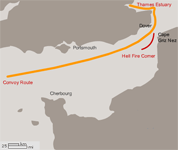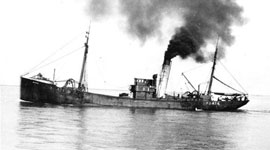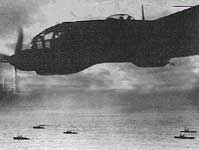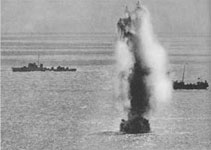Dennis saw his share of action over that period but remembers one convoy perhaps more clearly than any other. This convoy, coded CEB 201, was one that the Germans attempted to stop and moreover attempted to block on the Goodwin Sands in the English Channel. As a signalman he witnessed much of the action and anything that was missed would be learnt about in the in the messdeck after the battle. The written word is powerful, but it is doubtful that any words can capture the feelings of men in battle. Fear is ever present but when it should be at its greatest, as the enemy shells and bombs fall around, the disciplined and seasoned sailor buries himself in his job and finds the courage to get through it all. With a distance of thousands of miles and the passage of fifty years between the writer and the events, this text can only describe the hours of the battle. Try to feel the fear that the men on both sides felt and the anguish between the actions as they waited knowing that the attacks would come again. Also try to imagine what they felt as the Dover ships passed their charges to Thames Command and turned to sail through it all again.
 |
 |
|
 |
| |
| Map showing t he route of Convoy CEB 201 |
|
Photograph of pre-WW2 fishing trawler Lois.
First registered in 1917 as an Admiralty trawler under the name John Appelby |
"Hell Fire Corner"
On the 14th November 1942 our ship, HMT Lois was working with the group sweeping Dungeness East Roads. At sunset the ships dispersed for the night and carried out independent patrols. After an uneventful night the ships regrouped and swept towards the convoy CEB 201. They met the convoy while sweeping in formation and after "in sweeps", relieved the Portsmouth ships on the starboard side of the convoy. The Dover escorts lay between the convoy and the French coast in position to lay smoke and hide the convoy from the enemy range finders. The convoy had already been attacked twice by German destroyers and this had resulted in one collier sunk and an escort destroyer damaged and taken to Portland. The convoy was due to pass through the Goodwins at 0215 the next morning which meant "Hellfire Corner" and the English Channel in daylight making the convoy a good target for the guns and aircraft.
On the 14th November 1942 our ship, HMT Lois was working with the group sweeping Dungeness East Roads. At sunset the ships dispersed for the night and carried out independent patrols. After an uneventful night the ships regrouped and swept towards the convoy CEB 201. They met the convoy while sweeping in formation and after "in sweeps", relieved the Portsmouth ships on the starboard side of the convoy. The Dover escorts lay between the convoy and the French coast in position to lay smoke and hide the convoy from the enemy range finders. The convoy had already been attacked twice by German destroyers and this had resulted in one collier sunk and an escort destroyer damaged and taken to Portland. The convoy was due to pass through the Goodwins at 0215 the next morning which meant "Hellfire Corner" and the English Channel in daylight making the convoy a good target for the guns and aircraft.
Just after noon 15th November 1942 the convoy sailed in range of the cross Channel guns. A little over an hour later the first salvo of four landed and the Dover ships started laying smoke. The thick chemical smoke obscured the convoy for four hours. In that time 55 shells had been fired at the convoy and three colliers were damaged. One with its engine ripped from its mounts, one with fractured steam pipes and the third with engine trouble but still underway. The Lady Brassey and Lady Duncannon came out from Dover to take the damaged ships in tow but in the meantime two of the hard pressed escorts assisted the third ship. M.Ls from Dover arrived to take off the wounded and hurried them to the medical facilities at Dover.
The convoy was well scattered and the escorts tried to herd them into a defensible group when true to form the enemy bombers arrived. Five dive bombers and eight level bombers were met by a flight of spitfires. The spitfires took their toll but some of the enemy aircraft still managed to carry out attacks. Over the next 30 minutes there was hectic firing and some close eruptions as 500lb and 1000lb bombs exploded in the water but fortunately no hits. The peppering of shrapnel as it hits the bulkhead can sound like a fascinating tune, frightening but fascinating.
 |
 |
|
 |
| |
| German He 111 flying over an Allied convoy |
|
Shell fired from the battery at Cape Griz Nez explodes in amongst a convoy sailing close to Dover. |
The air attack concluded and the convoy regrouped and headed east towards the Goodwins and the night. Lois and her sister completed shepherding the damage ship to port and set out to catch the convoy. The navigator estimated the ships would catch the convoy about the North-West Goodwin Buoy. About 0200 on the 16th November 1942 all hell broke loose about 5 miles ahead. There was gunfight, explosions and star flares, it had to be the enemy's E Boats. These low profiled fast boats about 50ft (15.25m) long carried two torpedoes or mines as well as a 40mm cannon. Obviously they were attacking the convoy.
The typical operational profile for the E Boats was to drop three mines ahead of the convoy then lie behind a wreck to wait for the convoy to sail into the trap. The E Boats were trying to block the Goodwins channel by sinking ships in the cleared passage. This could have nearly halved the amount of coal delivered to London. As the E Boats attacked on this evening the escorts where well placed and they could not penetrate the convoy and had to run down the length of the convoy. This generally reduced the effectiveness of the attack as the angle the torpedo ran was very acute to the ship's track. It also allowed all the escorts to fire on the boats as they sped down as there were no friendly ships in the line of fire.
Lois and her sister were in the right place that night because out of the gloom the gunner saw a bow wave, all the guns on both ships opened fire on the two E Boats. Taken by surprise the enemy bridge crew on one boat disappeared in a flash as one of the 12 pound shells exploded. Both boats still sped into the night, both burning internally and with casualties onboard and likely to be out of service for months to come. In the short period of perhaps 15 seconds the two trawlers fired eleven 12 pound shells, two drums of 20mm cannon shells and 85 x 0.5" shells at the boats. Both received minor damage but fortunately no casualties.
The brief encounter over the ships continued towards the convoy and encountered a collier down by the bows. She had hit by a mine. The two ships stood by and helped the stricken merchant ship clear the channel where she dropped anchors and waited for the salvage ship. One of the auxiliary ships in Dover was manned with Artificers who boarded the damaged ships to make repairs and get them underway. The battle still raged on amongst the convoy so Lois and her sister continued to chase the convoy. They came upon another damaged collier, this time torpedoed and listing to port. Alongside her was one of the Dover group and our two ships joined in to push the damaged ship into the sands on the Downs side of the channel. A short while later another torpedoed and listing collier was assisted onto the sands. Ships left on the sands were either repaired or unloaded but most importantly they did not block the channel.
The Convoy gets through
The now trio of Dover ships moved up on the convoy which had by now regrouped and beaten off the enemy boats with the aid of three MGBs. The convoy sailed on through the English Channel to dawn. An hour after dawn and the convoy still two hours away from being reinforced by the Thames group, the enemy air force found us. The bombers came in four waves of three planes each. As the attack developed a flight of spitfires joined and downed four of the bombers for the loss of two spitfires. This didn't prevent the aircraft from pressing home the attack and the convoy lost another collier. The downed aircrews from both sides were picked up and the convoy resumed its journey to London. Two hours after the air attack the Thames group relieved the Dover ships and they turned back to retrace their steps. Intelligence confirmed six E boats had been involved in the convoy attack which meant 18 mines had been laid. As one had already found its mark it meant that there were 17 left to find before the next convoy passed westbound later that day. So the crews still weary from the night action, stood to and "out sweeps" . It was to be another long day before these ships could rest awhile. A second Dover group joined 17 mines were swept and the salvage crews then started work on the damaged colliers still in the Downs.
The cost of the convoy battle had been:
1 colliers lost,
3 damaged but repairable colliers with their cargo safe.
1 destroyer damaged
2 spitfires lost, and 18 wounded and 2 dead.
The enemy costs were revealed later and were heavier in terms of men if not in machinery. The German losses were:
1 damaged E boat subsequently written off,
3 damaged E boats out of action for 4 weeks,
1 damaged E boat out of action for 2 weeks,
1 damaged E boat out of action for 3 days,
4 aircraft lost and crews captured.
Worst of all for the Germans is that they did not achieve the goal of blocking the channel. The British did get the convoy through and despite the enemies efforts maintained the power stations for another week.
Denis Colthorpe 2000
|